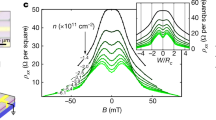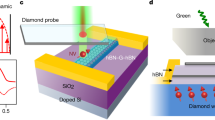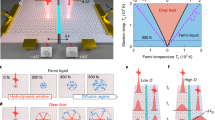Abstract
Electrical resistance usually originates from lattice imperfections. However, even a perfect lattice has a fundamental resistance limit, given by the Landauer1 conductance caused by a finite number of propagating electron modes. This resistance, shown by Sharvin2 to appear at the contacts of electronic devices, sets the ultimate conduction limit of non-interacting electrons. Recent years have seen growing evidence of hydrodynamic electronic phenomena3,4,5,6,7,8,9,10,11,12,13,14,15,16,17,18, prompting recent theories19,20 to ask whether an electronic fluid can radically break the fundamental Landauer–Sharvin limit. Here, we use single-electron-transistor imaging of electronic flow in high-mobility graphene Corbino disk devices to answer this question. First, by imaging ballistic flows at liquid-helium temperatures, we observe a Landauer–Sharvin resistance that does not appear at the contacts but is instead distributed throughout the bulk. This underpins the phase-space origin of this resistance—as emerging from spatial gradients in the number of conduction modes. At elevated temperatures, by identifying and accounting for electron–phonon scattering, we show the details of the purely hydrodynamic flow. Strikingly, we find that electron hydrodynamics eliminates the bulk Landauer–Sharvin resistance. Finally, by imaging spiralling magneto-hydrodynamic Corbino flows, we show the key emergent length scale predicted by hydrodynamic theories—the Gurzhi length. These observations demonstrate that electronic fluids can dramatically transcend the fundamental limitations of ballistic electrons, with important implications for fundamental science and future technologies.
This is a preview of subscription content, access via your institution
Access options
Access Nature and 54 other Nature Portfolio journals
Get Nature+, our best-value online-access subscription
$29.99 / 30 days
cancel any time
Subscribe to this journal
Receive 51 print issues and online access
$199.00 per year
only $3.90 per issue
Buy this article
- Purchase on Springer Link
- Instant access to full article PDF
Prices may be subject to local taxes which are calculated during checkout




Similar content being viewed by others
Data availability
Source data are provided with this paper. Additional data that support the plots and other analysis in this work are available from the corresponding author upon request.
References
Landauer, R. Spatial variation of currents and fields due to localized scatterers in metallic conduction. IBM J. Res. Dev. 1, 223–231 (1957).
Sharvin, Y. V. A. Possible method for studying Fermi surfaces. Sov. Phys. JETP 21, 655 (1965).
de Jong, M. J. M. & Molenkamp, L. W. Hydrodynamic electron flow in high-mobility wires. Phys. Rev. B 51, 389–402 (1995).
Bandurin, D. A. et al. Negative local resistance caused by viscous electron backflow in graphene. Science 351, 1055–1058 (2016).
Crossno, J. et al. Observation of the Dirac fluid and the breakdown of the Wiedemann-Franz law in graphene. Science 351, 1058–1061 (2016).
Moll, P. J. W., Kushwaha, P., Nandi, N., Schmidt, B. & Mackenzie, A. P. Evidence for hydrodynamic electron flow in PdCoO2. Science 351, 1061–1064 (2016).
Krishna Kumar, R. et al. Superballistic flow of viscous electron fluid through graphene constrictions. Nat. Phys. 13, 1182–1185 (2017).
Gooth, J. et al. Thermal and electrical signatures of a hydrodynamic electron fluid in tungsten diphosphide. Nat. Commun. 9, 4093 (2018).
Braem, B. A. et al. Scanning gate microscopy in a viscous electron fluid. Phys. Rev. B 98, 241304 (2018).
Berdyugin, A. I. et al. Measuring Hall viscosity of graphene’s electron fluid. Science 364, 162–165 (2019).
Tan, C. et al. Realization of a universal hydrodynamic semiconductor in ultra-clean dual-gated bilayer graphene. Sci Adv. 8, eabi8481 (2022).
Sulpizio, J. A. et al. Visualizing Poiseuille flow of hydrodynamic electrons. Nature 576, 75–79 (2019).
Ku, M. J. H. et al. Imaging viscous flow of the Dirac fluid in graphene. Nature 583, 537–541 (2020).
Jenkins, A. et al. Imaging the breakdown of ohmic transport in graphene. Preprint at https://arxiv.org/abs/2002.05065 (2020).
Keser, A. C. et al. Geometric control of universal hydrodynamic flow in a two-dimensional electron fluid. Phys. Rev. X 11, 031030 (2021).
Gupta, A. et al. Hydrodynamic and ballistic transport over large length scales in GaAs/AlGaAs. Phys. Rev. Lett. 126, 076803 (2021).
Krebs, Z. J. et al. Imaging the breaking of electrostatic dams in graphene for ballistic and viscous fluids. Preprint at https://arxiv.org/abs/2106.07212 (2021).
Vool, U. et al. Imaging phonon-mediated hydrodynamic flow in WTe2. Nat. Phys. https://doi.org/10.1038/s41567-021-01341-w (2021).
Shavit, M., Shytov, A. & Falkovich, G. Freely flowing currents and electric field expulsion in viscous electronics. Phys. Rev. Lett. 123, 026801 (2019).
Stern, A. et al. Spread and erase – how electron hydrodynamics can eliminate the Landauer-Sharvin resistance. Preprint at https://arxiv.org/abs/2110.15369?context=cond-mat.str-el (2021).
Gurzhi, R. N. Minimum of resistance in impurity free conductors. Sov. Phys. JETP 17, 521 (1963).
Nagaev, K. E. & Ayvazyan, O. S. Effects of electron-electron scattering in wide ballistic microcontacts. Phys. Rev. Lett. 101, 1–4 (2008).
Nagaev, K. E. & Kostyuchenko, T. V. Electron-electron scattering and magnetoresistance of ballistic microcontacts. Phys. Rev. B 81, 1–9 (2010).
Andreev, A. V., Kivelson, S. A. & Spivak, B. Hydrodynamic description of transport in strongly correlated electron systems. Phys. Rev. Lett. 106, 256804 (2011).
Torre, I., Tomadin, A., Geim, A. K. & Polini, M. Nonlocal transport and the hydrodynamic shear viscosity in graphene. Phys. Rev. B 92, 165433 (2015).
Levitov, L. & Falkovich, G. Electron viscosity, current vortices and negative nonlocal resistance in graphene. Nat. Phys. 12, 672–676 (2016).
Scaffidi, T., Nandi, N., Schmidt, B., Mackenzie, A. P. & Moore, J. E. Hydrodynamic electron flow and Hall viscosity. Phys. Rev. Lett. 118, 226601 (2017).
Guo, H., Ilseven, E., Falkovich, G. & Levitov, L. S. Higher-than-ballistic conduction of viscous electron flows. Proc. Natl Acad. Sci. USA 114, 3068–3073 (2017).
Narozhny, B. N., Gornyi, I. V., Mirlin, A. D. & Schmalian, J. Hydrodynamic approach to electronic transport in graphene. Ann. Phys. 529, 1700043 (2017).
Holder, T. et al. Ballistic and hydrodynamic magnetotransport in narrow channels. Phys. Rev. B 10, 245305 (2019).
Levchenko, A. & Schmalian, J. Transport properties of strongly coupled electron–phonon liquids. Ann. Phys. 419, 168218 (2020).
Hong, Q., Davydova, M., Ledwith, P. J. & Levitov, L. Superscreening by a retroreflected hole backflow in tomographic electron fluids. Preprint at https://arxiv.org/abs/2012.03840 (2020).
Honig, M. et al. Local electrostatic imaging of striped domain order in LaAlO3/SrTiO3. Nat. Mater. 12, 1112–1118 (2013).
Ella, L. et al. Simultaneous voltage and current density imaging of flowing electrons in two dimensions. Nat. Nanotechnol. 14, 480–487 (2019).
Wang, L. et al. One-dimensional electrical contact to a two-dimensional material. Science 342, 614–617 (2013).
Ben Shalom, M. et al. Quantum oscillations of the critical current and high-field superconducting proximity in ballistic graphene. Nat. Phys. 12, 318–322 (2016).
Efetov, D. K. & Kim, P. Controlling electron-phonon interactions in graphene at ultrahigh carrier densities. Phys. Rev. Lett. 105, 256805 (2010).
Waissman, J. et al. Realization of pristine and locally tunable one-dimensional electron systems in carbon nanotubes. Nat. Nanotechnol. 8, 569–574 (2013).
Acknowledgements
We thank L. Ella, G. Falkovich, L. Levitov, M. Polini, M. Shavit, A. Rozen, A. V. Shytov and U. Zondiner for useful discussions. Work was supported by the Leona M. and Harry B. Helmsley Charitable Trust grant, ISF grant (no. 1182/21), Minerva grant (no. 713237), Hydrotronics (no. 873028) and the ERC-Cog (See-1D-Qmatter, no. 647413). T.S. acknowledges the support of the Natural Sciences and Engineering Research Council of Canada (NSERC), in particular the Discovery Grant (no. RGPIN-2020-05842), the Accelerator Supplement (no. RGPAS-2020-00060) and the Discovery Launch Supplement (no. DGECR-2020-00222). During the preparation of this manuscript, we became aware of a partially related STM work17, which images voltage drops in flows across a constriction.
Author information
Authors and Affiliations
Contributions
C.K., J.B., J.A.S, A.K.G. and S.I. designed the experiment. C.K., J.B. and J.A.S. performed the experiments. J.B. and D.P. fabricated the devices. C.K., J.B., J.A.S. and S.I. analysed the data. T.S., A.S. and S.I. wrote the theoretical model. K.W. and T.T. supplied the hBN crystals. C.K., J.B., A.S. and S.I. wrote the manuscript with input from other authors.
Corresponding author
Ethics declarations
Competing interests
The authors declare no competing interests.
Peer review
Peer review information
Nature thanks Yonglong Xie and the other, anonymous, reviewer(s) for their contribution to the peer review of this work.
Additional information
Publisher’s note Springer Nature remains neutral with regard to jurisdictional claims in published maps and institutional affiliations.
Supplementary information
Supplementary Information
Supplementary Sections 1–18: Device fabrication; transport measurements; angular symmetry of the measured flow; measurement of the point-spread function (PSF) of the imaging experiments; determining the contact transparency from the measured resistance profile; determining the momentum-relaxing mean-free path over the full temperature range; additional data at a different carrier density; imaging measurements on a second Corbino device; comparing resistance profiles at different temperatures but with similar lMR; the Irrelevance of bulk magneto-resistance contributions; measurement of the Hall angle profile at T = 180 K; temperature dependence of lee; derivation of equation (1) in the main text; Boltzmann simulations of interacting flow in a Corbino geometry; temperature dependence of the outer contact resistance; the dependence of the number of conduction modes on radius in a Corbino device; the physical significance of the resistance function R(r) and accuracy in R(r) measurements from Nanotube SET sensitivity. Supplementary Figures 1–12 and additional references.
Rights and permissions
Springer Nature or its licensor holds exclusive rights to this article under a publishing agreement with the author(s) or other rightsholder(s); author self-archiving of the accepted manuscript version of this article is solely governed by the terms of such publishing agreement and applicable law.
About this article
Cite this article
Kumar, C., Birkbeck, J., Sulpizio, J.A. et al. Imaging hydrodynamic electrons flowing without Landauer–Sharvin resistance. Nature 609, 276–281 (2022). https://doi.org/10.1038/s41586-022-05002-7
Received:
Accepted:
Published:
Issue Date:
DOI: https://doi.org/10.1038/s41586-022-05002-7
This article is cited by
-
Anomalous electronic transport in high-mobility Corbino rings
Nature Communications (2023)
-
Charge transport and hydrodynamics in materials
Nature Reviews Materials (2023)
-
Para-hydrodynamics from weak surface scattering in ultraclean thin flakes
Nature Communications (2023)
-
Non-dissipative electrically driven fluids
Journal of High Energy Physics (2023)
-
Perspective: nanoscale electric sensing and imaging based on quantum sensors
Quantum Frontiers (2023)
Comments
By submitting a comment you agree to abide by our Terms and Community Guidelines. If you find something abusive or that does not comply with our terms or guidelines please flag it as inappropriate.



